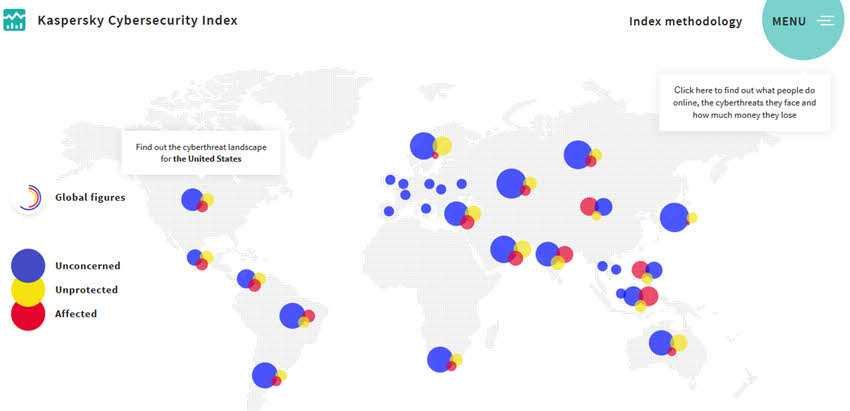Kaspersky Lab has updated the Kaspersky Cybersecurity Index, a set of parameters that allow it to evaluate risk levels for internet users worldwide. The index for the second half of 2016 shows a positive trend: the number of people concerned about its security - and ready to protect itself from digital threats - is constantly increasing.
The index is based on an online survey involving Internet users from around the world and conducted by Kaspersky Lab twice a year. In the second half of 2016, 17.377 people responded from 28 countries.
This year, the index has undergone a slight change: the main indicators have been revised to better reflect the digital life of users in different countries. Currently, Kaspersky Cybersecurity Index contains three main indicators:
· Indifferent - the percentage of users who do not believe they can be targeted by digital crime.
· Unprotected – the number of users who have not installed a security solution on their computers, tablets and smartphones their.
· Victims - the percentage of users who have been the victims of digital crime. In the second half of 2016, the list of incidents related to this index increased significantly.
Users of the Kaspersky Cybersecurity Index can now view statistics on specific financial losses that have occurred as a result of cybercriminal activity, as well as compare data from different user groups (for example, smartphone use among senior citizens in the U.S. and young people in Sweden).
The global index for the second half of the year (Indifferent - Unprotected - Victims) was 74-39-29. This means that 74% of users do not believe they can fall victim to digital criminals, 39% of respondents do not use security solutions on their connected devices, and 29% of those surveyed are 'infected' by digital attacks months. Last year's index was 79-40-29, which means that 6 months ago more people thought they were untouchable and preferred to remain unprotected.
The percentage of victims of digital crime remains the same (29%) because this indicator in the current update has changed. To have a clearer one picture, the list of digital threats now includes "financial fraud" and "devices used in digital attacks", without which the average "victim" rate worldwide could be 27% instead of 29%. In fact, this means that the number of victims in the second half of 2016 decreased at the same time as the responsibility of users regarding their personal safety increased.
For example, the number of users who encountered malware was down from 22% to 20%. Costs to eliminate the effects of "infection" decreased from $ 121 to $ 92. However, the percentage of those who have fallen victim to other types of threats has increased. For example, the number of users who have fallen victim to ransomware, phishing, data theft and data leaks has increased. At the same time, the average money stolen from online crooks increased from $ 472 to $ 482.
“Kaspersky Lab's Digital Security Index for the second half of 2016 shows positive dynamics that we hope will continue. At Kaspersky Lab we do everything we can to inform as many people as possible about digital threats and how to deal with them. Our goal is to make the digital world safe for everyone. We work for a world where people don't lose their data, their digital identity and their money to the machinations of digital criminals. The Kaspersky Cybersecurity Index is one of the steps towards this goal", comments Andrei Mochola, Head of Consumer Kaspersky Lab Business.
In addition to the Index itself and financial losses, the site contains additional information that creates an image of the modern Internet user. For example, site statistics show that the number of Internet-connected devices in an average family continues to grow: in the first half of the year there were 5,9 devices per family, and in the second half this number reached 6,3. It is also evident that more and more users are using electronic banking services (59% in the first half versus 77% in the second), making online purchases (73% vs. 90%) and using digital payment systems (44% vs. 65%).





